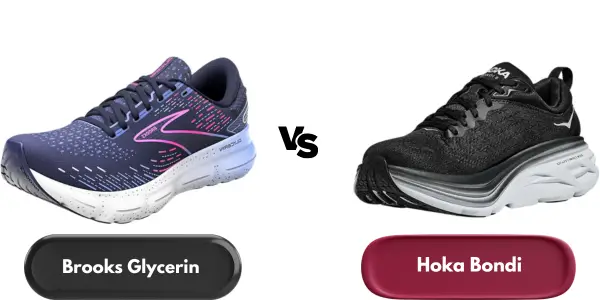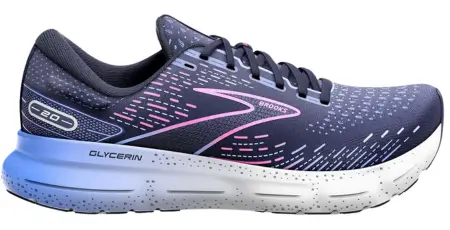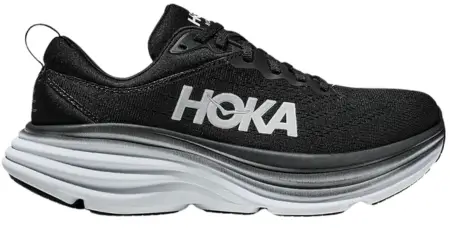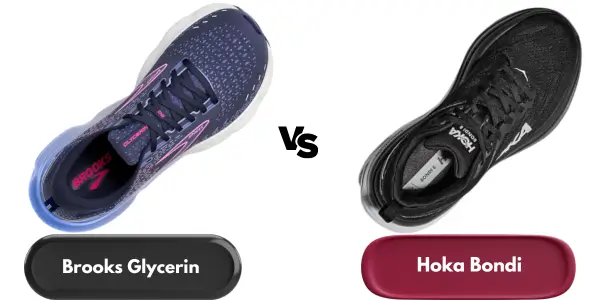Brooks Glycerin Vs Hoka Bondi: Difference of Running Shoe
Last Updated: January 01, 2025 | Author: Jake Thompson
In the competitive world of cushioned running shoes, two giants stand out: Brooks Glycerin and Hoka Bondi. Each has its legion of fans, eagerly debating their merits on runs around the globe.
If you're on the hunt for a shoe that doesn't just fit your foot but complements your running journey, you're in the right place. This exploration into the nuances of Brooks Glycerin vs Hoka Bondi isn't just about comparing features. It's about finding a partner for every mile ahead.
So, tighten your laces and get ready for a deep dive into what makes these shoes stand out from the pack. Keep reading to discover which contender might just be the perfect match for you.

Table of Content:
- Key Takeaways
- Table: Brooks Glycerin 20 vs Hoka Bondi 8
- Pros & Cons
- The Contenders: Unveiling Brooks Glycerin vs Hoka Bondi
- Cushioning Face-Off: Nitrogen-Infused DNA Foam vs. Ultra Thick Foam
- Design and Aesthetics: Running in Style
- Durability and Value: Mile After Mile Investment
- Fit and Comfort: Finding Your Perfect Match
- Toe Box and Midfoot: Space and Support
- Heel Counter and Arch Support: Stability in Every Step
- Performance on the Road: Traction, Flexibility, and Ride
- Tackling the Terrain: Outsole Durability and Design
- The Feel of the Road: Response and Energy Return
- Final Verdict
- Frequently Asked Questions
Key Takeaways
- - Brooks Glycerin is lighter for men, while Hoka Bondi is lighter for women.
- - Hoka Bondi has a higher stack height, offering more cushioning.
- - Brooks Glycerin features an 8mm drop, compared to Hoka Bondi's 4mm drop.
- - Glycerin focuses on soft cushioning, whereas Bondi provides wide-footprint support.
Table: Brooks Glycerin 20 vs Hoka Bondi 8

|

|
|
|---|---|---|
| Feature | Brooks Glycerin 20 | Hoka Bondi 8 |
| Terrain | Road | Road |
| Pace | Daily running | Daily running |
| Toebox | Medium | Narrow |
| Pronation | Underpronation, Supination, Neutral Pronation | Underpronation, Supination, Neutral Pronation |
| Arch Support | Neutral | Neutral |
| Heel to Toe Drop | 10mm | 4mm |
| Weight | 286g | 311g |
| Cushioning | Plush | Plush |
| For Big Guys | - | ✓ |
| Breathable | ✓ | ✓ |
| Comfortable | ✓ | ✓ |
| For Heavy Runners | - | ✓ |
| Maximalist | ✓ | ✓ |
| Orthotic Friendly | ✓ | ✓ |
| Removable Insole | ✓ | ✓ |
| Rocker | - | ✓ |
| Sustainable | ✓ | - |
| Distance | Long distance | Long distance |
| Widths Available | Normal, Wide | Normal, Wide, X-Wide |
| All-day Wear | ✓ | ✓ |
| For Beginners | ✓ | ✓ |
| Jogging | ✓ | ✓ |
| Treadmill | ✓ | - |
| Walking | ✓ | ✓ |
| Strike Pattern | Heel strike | Forefoot/Midfoot strike |
| Arch Type | High arch | High arch |
| Flexibility | Moderate | Stiff |
| Material | Mesh | Mesh |
| Season | Summer | Winter |
| Release Date | Jul 2022 | Jul 15, 2022 |
| No of Colorways | 49 | 63 |
| Forefoot Height | 24mm | 35mm |
| Heel Height | 34mm | 39mm |
| Price |
Pros & Cons
Brooks Glycerin
Pros:- - Versatile for daily running, suitable for various activities.
- - Supports underpronation, supination, and neutral pronation.
- - Plush cushioning for long-distance comfort.
- - Breathable, sustainable, and orthotic-friendly design.
- - Suitable for jogging, walking, and treadmill use.
- - 10mm heel-to-toe drop may not suit all preferences.
- - Not specifically designed for heavier runners.
- - Less ideal for colder weather.
Hoka Bondi
Pros:- - Accommodates heavier runners.
- - Natural running position with a 4mm drop.
- - Wide, X-wide sizes; maximalist cushioning.
- - Orthotic-friendly, rocker design.
- - Narrow toebox.
- - Not sustainable.
- - Better for winter, not for treadmill.
The Contenders: Unveiling Brooks Glycerin vs Hoka Bondi
In my experience of running marathons and helping folks find the perfect Hoka running shoes and Brooks running shoes at my store two shoes that really stand out. Let me tell you about them.
Brooks Glycerin is super soft and comfy, like running on clouds. They give you a nice bounce without making your feet feel tired, which is great for when I'm aiming for those extra miles. I remember this one time during a marathon, around mile 20, when my legs were screaming, but my feet? They were just fine, thanks to these shoes.
Then, there's Hoka Bondi that's like a big hug for your feet. They've a lot of space and make sure your feet are stable and supported, no matter how far you run. I once wore these on a particularly rocky and uneven trail. While others were complaining about their feet hurting, mine felt as steady as if I was running on a smooth track.
Choosing between Brooks Glycerin and the Hoka Bondi it really comes down to what you like better. Do you want to feel like you're bouncing along the road with soft, supportive shoes? Or do you prefer to have your feet feel super secure and comfy, ready to tackle any distance?
From my experience, both are amazing choices for long runs. It's all about what feels best for your feet and matches your running style. So, think about what you like, and go for the one that will make those miles feel like a breeze.
Cushioning Face-Off: Nitrogen-Infused DNA Foam vs. Ultra Thick Foam

There are two different kinds of cushioning in these popular running shoes and how they feel when you're pounding the pavement mile after mile.
First, there's Nitrogen-Infused DNA foam cushioning that feels like a mix of being super soft. It gives you a little bounce back with every step you take. It's like stepping on a really bouncy cloud.
I remember running a half-marathon in a pair, and it was like my feet were getting a gentle hug with every step. Even towards the end, when my legs were screaming, my feet felt surprisingly good.
Then, there's Ultra Thick Foam cushioning that's all about being soft and thick, like walking on a big, squishy mattress. This kind is awesome for those super long runs where you're out for hours and your whole body starts to feel the impact. I used these for my longest training runs, and it made a huge difference. My legs and feet didn't feel as beat up the next day, which meant I could get back out there sooner.
The bouncy, amount of cushioning is excellent for feeling fast and light. This is particularly beneficial when trying to pick up the pace. It's also great for a variety of workouts. However, for long distances, thick, squishy mattress cushioning is preferable.
It helps keep your feet feeling fresh mile after mile. I've seen how different runners have different needs and preferences. Some like that quick, responsive feeling underfoot, while others just want to sink into comfort, especially over long distances.
Having tried out so many shoes in all the miles I've run, I can say there's definitely no one-size-fits-all. Understanding these differences has greatly aided me in recommending the right shoes to other runners. This ensures they achieve the comfort and performance they seek.
Design and Aesthetics: Running in Style
When choosing a running shoe, how it looks and feels are just as important as the technical stuff, like how soft it feels and how well it fits. I've run in a lot of shoes, and I've noticed that the way a shoe looks can really make you want to pick it over another.
I remember Glycerin, sleek and modern, making me feel like I was running faster just by wearing it. It was perfect for those who want to look and feel quick on their feet. Then there was Hoka Bondi, super colorful with a big, comfy sole. These shoes stood out and were great for runners who wanted to show off their style while staying comfy.
In my experience, running in these shoes wasn't just about how they performed but also how they made me feel. That Glycerin was a go-to for my city runs, blending in with the urban vibe. The Bondi on the other hand, were my pick for fun runs or when I was feeling bold. It's amazing how the design of a shoe can match different moods and settings.
Both types of shoes had their moments where they shone. The Brooks were great for those serious training days when I wanted to beat my personal best. The bold, comfy ones were perfect for long, leisurely runs when comfort was my top priority.
This just goes to show, how a shoe looks and feels matters a lot in picking the right one for your run. It's not just about the technical bits; it's about how the shoe fits your style and your running needs.
Durability and Value: Mile After Mile Investment
When looking for running shoes that can really go the distance, I've come across Glycerin 20 and Bondi 8. That stand out because of how long they last and the awesome support they give to runners like me.
- - Long-lasting Shoes: These shoes are amazing because they can take a lot of running without wearing out. I've run hundreds of miles in them, and they still feel great.
- - Great for Lots of Running: Even after putting a lot of miles on these shoes, they still keep my feet comfortable and supported. This is super important for someone who runs a lot.
- - Worth the Money: Since these shoes last so long and help me run better, I think they're a really good deal. It's like investing in a pair of shoes that will help you keep running happily for a long time.
- - Paying for Quality: The price you pay is totally worth it because of how many miles you can run in these shoes. It's like they're made to help you keep going without falling apart.
- - Investing in My Running: Choosing these shoes means I'm looking out for my future in running. They make sure I can keep hitting the pavement without worrying about my gear.
In my experience during those marathon training runs or even during the races themselves, having reliable shoes makes difference. They've helped me avoid blisters and sore feet, which can really mess up your training or race day. Plus, it's awesome not having to replace them all the time, which means more time focusing on improving my runs and less spending.
Fit and Comfort: Finding Your Perfect Match
Looking at the Brooks Glycerin 20 and Hoka Bondi 8, space for toes and midfoot is key for comfort and support. The Brooks fits tighter at the midfoot, which some runners prefer. In contrast, the Hoka Bondi offers more room, suiting different foot shapes. This shows the importance of selecting shoes based on personal needs.
Also, the back part of the shoe and the support under your arch can really change how the shoe feels. The second shoe offers more support under the arch of your foot. This is an important consideration for those needing extra stability and comfort with each step.
From running marathons and assisting others in finding optimal running gear, I've gained significant insights. I've learned what makes a shoe suitable for various runners. Specifically, during a marathon, I chose a shoe with more arch support.
This choice made a noticeable difference. My feet felt much better towards the race's end. They were less tired and sore, which really helped me push through those last few miles.
Toe Box and Midfoot: Space and Support
Throughout my marathon running and gear advising, I've realized specific shoes suit certain foot types. Notably, Brooks' Glycerin series offers generous toe space. This design benefits those with wide feet, providing notable comfort. These might seem like small details, but they make a huge difference in how comfortable and stable the shoe feels when I'm running.
Throughout my marathon experiences and gear recommendations, I've found certain shoes excel for specific feet. The Brooks Glycerin series stands out to me. They offer ample toe space. This is ideal for those with wide feet, providing superior comfort.
These shoes let my toes spread out without feeling squished, making my runs more enjoyable. Then there are Bondi series shoes with a tighter fit around the middle of the foot. This snugness gives me a secure feeling, especially on long runs, because I know my foot isn't going to slide around inside the shoe.
I remember one marathon where the choice of shoe made all the difference. It was a particularly rainy day, and the ground was slippery. My choice had a snug fit around the midfoot, which really helped keep my foot stable, preventing any slips or slides.
Runners with wider feet often prefer shoes that offer more room in the toe area. In contrast, those who favor a secure feeling tend to choose shoes with a tighter fit around the midfoot. It really comes down to what feels best for your feet.
Heel Counter and Arch Support: Stability in Every Step
When choosing running shoes, consider toe fit and midfoot feel. Also, check heel security and arch support. With the Glycerin shoe, the heel counter snugly hugs the back of your foot, ensuring minimal movement within the shoe.
This creates a feeling of stability and security during runs. The arch support in the Glycerin, while not overly pronounced, collaborates effectively with the shoe's plush cushioning. This is particularly evident on longer distances, ensuring comfort and stability throughout the run.
On the other hand, the Hoka Bondi shines with its exceptional arch support, providing a comforting embrace. Although the heel fit in the Bondi isn't as snug as the Glycerin. It still ensures that each step is secure and supported, making it another excellent choice for distance runners.
At first, these features might not look crucial. Yet, for marathon runners like me, they're vital. A shoe that grips your heel and supports your arch boosts comfort and stability. This can impact your performance over many miles. It's key to find shoes that offer the right mix of comfort and support.
Performance on the Road: Traction, Flexibility, and Ride
When it comes to road running shoes, I've run in a lot of them. There are two types I've tried that really stand out because of how they feel on the road.
The Brooks Glycerin is super grippy and flexible, making it feel like you're running smoothly and quickly. It's like the shoe is part of your foot, helping you move easily. This shoe is great for feeling fast and comfortable at the same time.
The other type, the Hoka Bondi, is like a big, soft pillow for your feet. It's wider, so you feel super stable, and it's like running on clouds because it absorbs the bumps really well. This shoe excels for long runs; your feet stay less tired. It feels like receiving a gentle hug with every step.
Through my marathon experiences, I've discovered the Brooks Glycerin shines for feeling fast and light, particularly on short runs. It's like the shoe helps you push off the ground better. But for those really long runs, where your feet start feeling every little rock and stick, the Hoka Bondi is a lifesaver. It makes a big difference in how your legs feel miles in.
Tackling the Terrain: Outsole Durability and Design
When looking for the best shoes for running, I've tried out many. I found some interesting things about their soles, which is the bottom part of the shoe that touches the ground. The Brooks Glycerin has a sole designed to last a long time. This design is especially beneficial in areas that usually wear out fast.
This is great for runners who don't want to keep buying new shoes all the time. Shoe like the Hoka Bondi, offers amazing grip, making it perfect for running on different kinds of surfaces. Whether it's a rainy day on the streets or a light trail in the park, these shoes help keep you steady.
Both types of shoes, the Glycerin and the Bondi, are really strong and last a long time. They're made a bit differently to suit what different runners might need. For instance, the Brooks Glycerin works really well on city streets, giving a good balance between grip and comfort.
The Hoka Bondi, even with its extra cushioning, is surprisingly flexible. This means it lets your feet move more naturally, which is a big help when you're running on uneven ground.
From my experience running marathons, I have learned that selecting the right shoe is crucial. It is evident that the ideal shoe depends on the running environment. Moreover, considering the specific needs of one's feet is essential to ensure comfort and prevent injuries.
The Feel of the Road: Response and Energy Return
When it comes to running shoes, two kinds really stand out. They help you feel great while running and improve efficiency. I've noticed this from my own running experiences and customer feedback in my store.
One type, like the Brooks Glycerin, has this special cushioning that makes running feel really soft and comfy. It also helps you bounce back with each step. This makes running feel easier and more fun because it feels like the shoe is helping push you forward. I remember running a half marathon in these, and even towards the end, my feet still felt pretty good and not too tired.
The other kind of shoe, such as the Hoka Bondi, has a bigger and thicker sole, making it comfortable and supportive for longer runs. Although they're really comfy, they don't give that same quick bounce-back feeling the Brooks Glycerin does, especially because of their bigger soles. But, they're amazing for those long, slow runs where your main goal is to stay comfortable mile after mile. I wore these for a really long training run once, and my feet felt incredibly supported the whole way.
Both types of shoes, the Brooks Glycerin and the Hoka Bondi, have their special features. The Brooks Glycerin gives a boost with each step. The Hoka Bondi keeps feet comfortable, no matter the distance. It all depends on what you're looking for in a running shoe. From marathons to advising in my store, I've learned the right shoe significantly impacts your run.
Final Verdict
In conclusion, the Hoka Bondi leads in the Brooks Glycerin vs Hoka Bondi comparison. It's best for those who value cushioning and support on long runs. Bondi's thick sole and wide sizes fit broader feet and larger builds well. This ensures stability and comfort, minimizing fatigue.
Brooks Glycerin, notable for its lightweight versatility and plush cushioning, appeals for diverse activities. Yet, the Hoka Bondi excels with its comfort, wide fit, and orthotic support. It's the top choice for long-distance durability and support. This makes it the go-to option for long-haul runners in this comparison.
Frequently Asked Questions
1. What makes the Brooks Glycerin different from the Hoka Bondi in terms of cushioning?
The Brooks Glycerin uses a nitrogen-infused DNA midsole technology, providing a soft and buttery feel underfoot. It's designed for runners who love a plush, shock-absorbing experience. The Hoka Bondi provides a firm but comfortable ride with its full-length EVA midsole. It's perfect for those wanting extra support without added weight.
2. Are both the Brooks Glycerin and Hoka Bondi true-to-size?
Yes, both the Brooks Glycerin and Hoka Bondi are true to size. They offer a roomy fit, ensuring plenty of space for your feet to spread out comfortably. This is great news for runners who want a snug fit without squeezing their toes, allowing for a more comfortable and confident stride.
3. How do the outsoles of Glycerin and Bondi compare?
The Brooks Glycerin has a durable rubber outsole with grooves for flexibility and a natural stride. The Hoka Bondi features a carbon rubber outsole, lasting up to 25 miles. It offers firm traction and durability on roads.
4. Which shoe is better for someone whose carrying a bit of extra weight?
Both shoes are designed with ample cushioning to support runners carrying extra weight. The Hoka Bondi, with its 38mm thick cushioning and wide base, offers more support and stability. It's ideal for heavier runners who need comfort and shock absorption.
5. How do the Brooks Glycerin and Hoka Bondi hold up over long distances?
The Brooks Glycerin has a soft, nitrogen-infused midsole. It softens impact over long distances. This makes it great for runners wanting a smooth ride.
The Hoka Bondi is also for long distances. It has durable construction and firm cushioning. Runners stay comfortable and confident, even after 20-25 miles. Both are excellent choices for marathon training or extended runs.
Share this:







